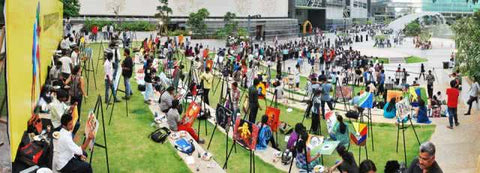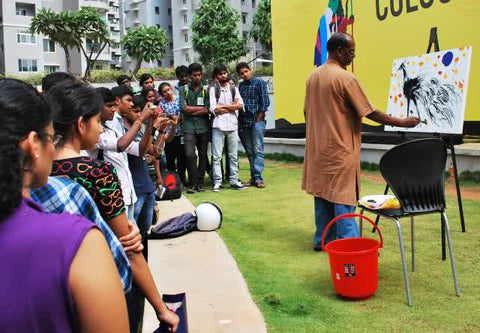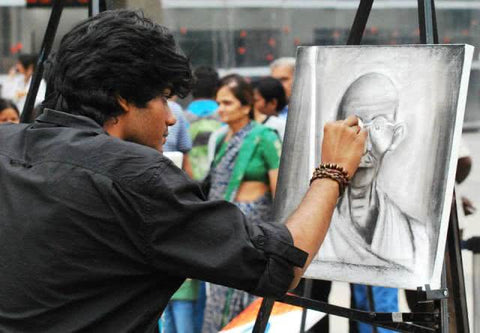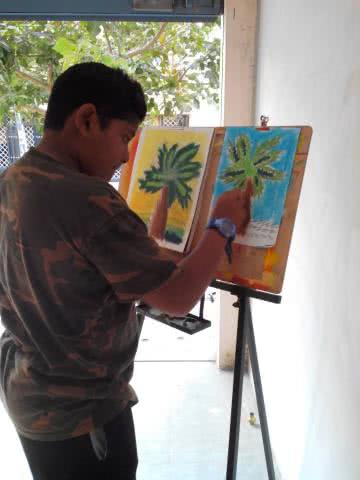Meet Roshan George, the founder of Artville, a Bangalore based contemporary art gallery and art school.
Artville contemporary opened its first gallery on 26th January 2011 with the ethos of preserving creativity and originality of art without compromising the artist's integrity. After few months, Artville launched its art training programs as an outreach activity of the gallery. Their specially designed training programs attracted a huge crowd and soon became popular. So far, the school has successfully trained over 200 students.
What prompted you to start Artville?
I always thought that I am a good artist but when I saw the works of others I realised it is better to be an art promoter than an artist. I was confident that I can create a platform using all my resources for those who are focused and want to establish themselves in the art industry. I initially wanted to open an art gallery in Delhi back in 2000 but it just didn’t work out then. I came back to Bangalore with the desire to develop a similar art loving community and promote deserving serious artists. Then, everything just fell in place. My wife went for her studies to UK and I got a hefty bonus from my company which I invested in opening Artville.
What challenges did you face in establishing Artville?
It all started with a Facebook group that gradually took shape of Artville. I created this group to upload my artworks and works of other amateur artists, and soon it became a platform for interaction. After 3-4 months, I opened the first Artville gallery. The model was that artists could reside and exhibit their works in the gallery. But it did not work out well. Those days no one knew about Artville and moreover I was not too keen on developing a business. It was more of an amateur artist hub. After opening this gallery, it took me almost a year to understand the depth and breadth of the art business. I visited as many artists, galleries, curators and critics I could and consolidated the ideas. Then, I started focusing on my business.
Artville has recently announced the second edition of live painting event 'Remembering the Mahatma'. Can you throw some light on the nature of this event and what purpose does it serve?
After starting Artville, we organized many shows in the gallery but could not actually make people understand the value of original art and the importance of art in our era – Contemporary art. So we decided to take these events to public spaces. For our first event, we tied up with Phoenix MarketCity and held a live painting event where approx. 100 artists participated. It was a huge success. Then, we started our training programs at Mantri Mall and soon garnered attention. We did 3 events at Mantri mall as well. In 2012, Orion Mall contacted us to do an event on Gandhi Jayanthi and we held a live painting event that saw 143 artists painting live at the mall. It attracted a huge crowd. We repeated the same event in 2013 and this time we managed to sell over 30 paintings in 2 days. This year too we will be doing it at Orion mall as they want us to make it an annual event.

Remembering the Mahatma, October 2013

JMS Mani - A well known artist inaugurating the event by doing a live painting

How are your art training programs different from that of others?
We believe that a conventional approach towards art training does not work for a group that has participants with different skill sets and different ideas. So, we took guidance from many successful artists and designed a methodology to make our trainings effective. Our network of more than 1000 artists helped us to come out with a unique and professional approach towards art training. We focus on:
- Creative thinking
- Concept development
- Skill development
- Successful execution of thoughts into art
Our trainers are successful practicing artists of international repute. We see ourselves as facilitators and not as trainers and hence ensure that the ambience is very liberal and inspirational. Moreover, our gallery provides a platform to deserving students to exhibit their works thus facilitating their entry into the contemporary art world.


The success of the Artville programs can be gauged from the experiences of people who have were/ are associated with the platform.
“What is unique about their programs is the freedom they offer to students. They don’t believe in giving too many directions. The trainers demonstrate a technique, a method and then allow students to think independently and create thus broadening the scope to experiment.”
- Mary Paul (a parent whose daughter [10] and son [13] are attending the training programs.)
“First, the trainers are highly professional and introduce you to the nuances of art. Be it the paper to be used or brushes to be selected, you are taught every basic and minute detail of the technique. Second is the freedom and comfort level that prevails in the ambience. If anyone truly wants to unleash his/her creativity then Artville is the place to be.”
- Madhuri (an Artville student)
Any international exhibitions held so far?
No, we are still growing. May be by the end of 2015 you will see it.
In what ways has Artville succeeded in increasing art awareness and bringing about a change in the art scene in Bangalore?
Not in a very high volume as people do not actually know what differentiates one artwork from the other. We are trying our best to create awareness in the city. Bangalore is no more a small city so our main focus is to create awareness in our neighbourhoods; and of course the public events give us a chance to reach out to large crowds.
Being a practicing contemporary artist, how do you perceive art in your life?
I will never call myself a practicing artist as there are many out there who are really dedicated to their passion. But I always give value to a great piece of art. I mainly look into the thoughts behind an artwork and the style of execution. I never give value to a reproduced artwork and believe that art is unique and needs to be original.
How has the art scene in India evolved in the last decade?
Revenue wise, the first half of the last decade was very good even though I was not in the business and could not actually experience the art boom. At the same time, the art market was rife with speculations and owing to lack of proper information many investors blindly invested in the artists and the galleries and eventually ended up in losing their money. Second half of the decade was not very pleasant as the market went down and most of the artists struggled save a few established names.
If revenue is not a parameter, then I would say that the Indian art scene took a big leap. The decade witnessed the opening of several new art galleries and art auction houses. The most positive change was the starting of art fairs especially the Kochi Biennale, the most remarkable of all. Kochi Muziris Biennale is an art event which every Indian should be proud of. Not only it gives exposure to contemporary Indian artists but it also brings the works of international artists to India which otherwise would not have been possible.
What major challenges Indian contemporary artists are facing today?
In my observation, many artists need expert guidance on how to build their profiles, which galleries to work with and so on. Many focused and dedicated artists are struggling. I think the most hurt are the mid-career artists as they cannot go down with the pricing and fail to get a better price for their works now. As a result, their space is acquired by decorative artists and reproduced artworks. In any case, if the buyer is not aware of the value of an original work the scene will never change. Therefore, galleries and artists must start contributing towards creating awareness among the old and new buyers.
With the increase in the number of art galleries and auction houses, do you think Indian art is coming out of the clutches of the elite and increasingly becoming accessible and affordable to middle-class people as well?
There is a classification in art galleries and auction houses. It is just like artists - established, upcoming, beginners/youngsters. If you are really keen and focused, everyone will have their own business and everyone must contribute to the society too!
Where do you see Indian contemporary art in next 10 years?
The Indian contemporary art will grow but the growth will be gradual and I feel the art market will correct its mistake. If we repeat the same mistakes we did in the previous art boom, the industry will collapse and every one will go through a bad time.
What are your future plans for Artville?
To create a unique online portal;
Take our training programs to the next level; and
Execute a few International projects in three cities - two in Europe and one in the USA.
I am not in a hurry. Things are moving slowly but steadily. I seriously think that it is also time for me to have a good team.
ArtZolo's special correspondent:
Reema Mittal









